We independently evaluate all recommended products and services. Any products or services put forward appear in no particular order. If you click on links we provide, we may receive compensation.
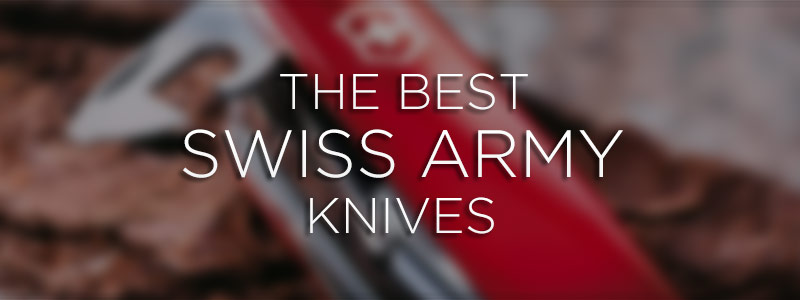
Why was Macgyver such a popular figure that he became part of the American social zeitgeist? People liked Macgyver because he used brains instead of violence to solve problems – he’d diffuse a bomb with a paperclip, a piece of gum, and a screwdriver. The bad guys were locked up, the day was saved, and no blood was spilled. And Macgyver was known for always having a Swiss Army Knife in his pocket to save the day and figure out a problem.
Victorinox (the maker of the Swiss Army Knife) has a long history, dating all the way back to 1884 – when Karl Elsener I opened a cutlery workshop in Ibach-Schwyz, Switzerland. The name of the company was derived from a combination of his mother – Victoria, who was a supporter of Karl’s work from the beginning – and Inox, the Swiss word for “stainless.” They made the first Swiss Soldier knife in 1891, which was issued to enlisted officers and soldiers as a rifle maintenance tool as well as a way to open rations – it packed a large blade, a larger straight screwdriver, an awl and a can opener.
The durability and convenience of the original Soldier knife meant it was issued to the army for more than 50 years, when it was replaced by the Alox-handled 93mm Soldier – which we still know today as the Pioneer. (spoiler alert.) Since the first knife in the late 19th century, Victorinox has produced more than 500 million Swiss Army Knives. They’re ubiquitous and excellent at what they’re designed for.
With that in mind, how can we narrow down a list of the best ones? Well, we’ll certainly try. Here are Knife Informer’s favorite Swiss Army Knives – not a dud to be found among them, all of these models offer a variety of tools to make life easier depending on who you are and what you do.
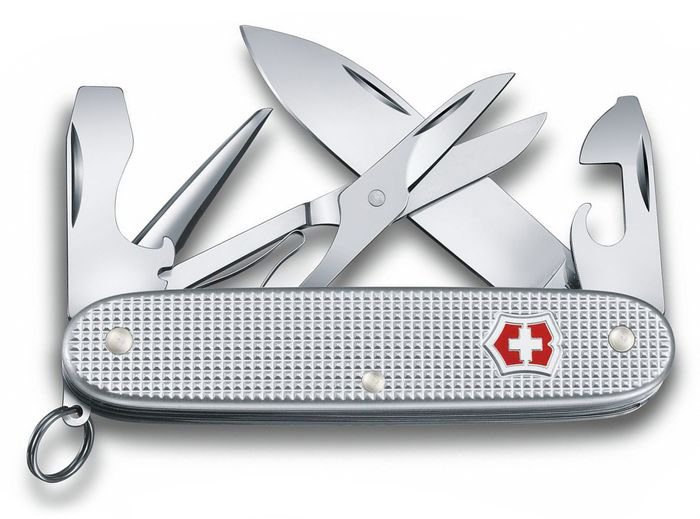
The Victorinox Pioneer was the “civilian” variant of the 1961 Soldier’s knife, but unlike some other military-to-civilian transformations (like the M16 to the AR15) the major difference between the Pioneer and the Soldier’s knife was a keyring. I suppose having a jangling set of keys makes soldiering more difficult – hard to sneak up on people. The Alox-handled Pioneer has been a consistently popular Swiss Army Knife for decades, offering all the stuff you need and nothing you don’t. It was a thin two-layer layout in the 93mm frame that packed a large blade, can opener/small screwdriver, cap lifter/wire stripper/large screwdriver, and a sharpened awl into a package that weighs only 2.47 ounces. I’ve had one for a long time, and it’s an invaluable tool.
They also made a model based on the Pioneer called the Farmer, which added a third layer with a serrated wood saw. People liked the wider grip that makes the Farmer more natural in the hand, but how often do you need a saw? Victorinox saw that people were going out of their way to modify the Pioneer with the addition of scissors, and they made their own factory produced three layer Pioneer with scissors, called the Pioneer X.
The addition of a third row only brings the weight up to 3.35 ounces, and the Pioneer X has been the answer to so many SAK lover’s dreams since it came out in 2015. It has all the tools you need for light around-the-house tasks – trimming strings, tightening wall plate screws, opening mail, clipping coupons, etc – with attractive, durable textured aluminum scales that won’t show wear even if they bounce around in a purse. A fantastic bit of EDC kit for any man or woman, and a great deal to boot.
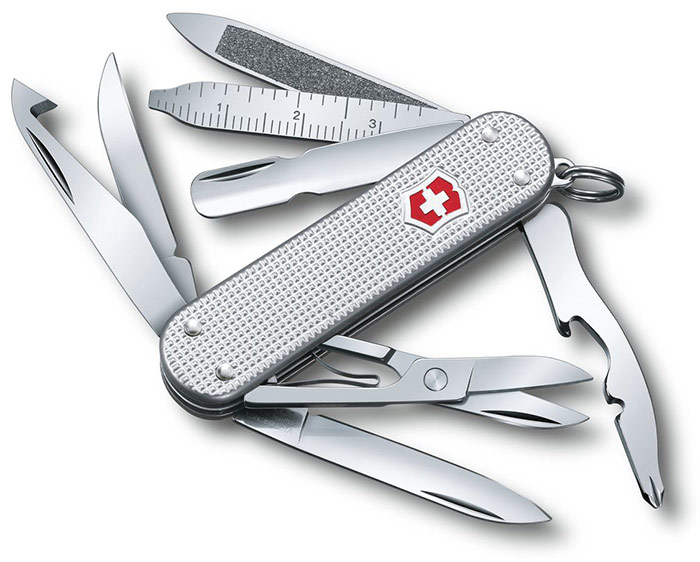
The Minichamp also made our “Best Keychain Multitools” list and it earns a spot here as well by packing so much into such a small package. The cellidor-handled model weighs a scant 1.56 ounces and packs 16 tools into a 58mm (2.2”) package. The Alox model ditches the scale-mounted tools for a total of 14 and drops the weight even lower, to 1.39 ounces. The MiniChamp is the same size as the ubiquitous Classic but is a three layer tool with components packed in on both sides. One side features a plain 1.25” blade and a pair of sprung scissors, with a unique multi-function tool opposite that includes a caplifter, wire stripper and magnetic Philips bit tip all in one. The other side of the tool packs 5 separate instruments with multiple functions – an orange peeler/scraper, letter opener, small screwdriver/ruler, a rounded cuticle pusher, and a nailfile/nail cleaner.
The plastic handled models also include tweezers and a ballpoint pen nested in the scales, which the Alox variants skip for a thinner profile and lighter weight. There are many variants of the MiniChamp – the Alox version was originally a SwissBianco exclusive but is now widely distributed. There’s also the Midnite MiniChamp, which replaces the tweezers with a small LED light that’s activated by pressing a momentary switch under the Victorinox logo.
The MiniChamp is a little spendy for a 58mm SAK – the Alox and Midnite versions are around the same price as the much larger Pioneer X – but it’s like a miniature toolbox that sits comfortably on a keychain, making everyday life a little easier.

Looking for the ideal Swiss Army Knife to take camping? That’s a tough question, because there is a nearly endless number of SAK variants aimed at outdoor enthusiasts. They’re even distributed by the Boy Scouts of America as camping equipment, which should tell you something! But for my money, the best SAK for camping is probably the Fieldmaster.
It’s based on the classic 91mm SAK frame (what most people consider to be the definitive Swiss Army Knife, and what most people picture in their head when referring to one) and includes 15 tools in four layers on both sides. The main blade is a 2.45” clip point, and there’s a can opener with a small screwdriver also on that side. Opposite those implements are a small paring knife, scissors, cap lifter/large screwdriver/wire stripper, and a serrated wood saw. The back side of the knife includes a Philips screwdriver, a sharpened awl/punch, and the mystifying “multipurpose hook” which can be used as a parcel carrier or a lace tightener. The cellidor scales contain the classic tweezers and toothpick, and there’s a keyring attachment. The whole knife weighs in at 3.56 ounces
There’s also the nearly identical Huntsman which swaps the Philips screwdriver for a corkscrew wine opener, depending on your priorities. And there’s the Huntsman Lite which adds the translucent “plus” scales with a battery powered LED light, a straight pin, a fine screwdriver nested in the corkscrew, a removable ballpoint pen, and an additional layer with an inline Philips driver.
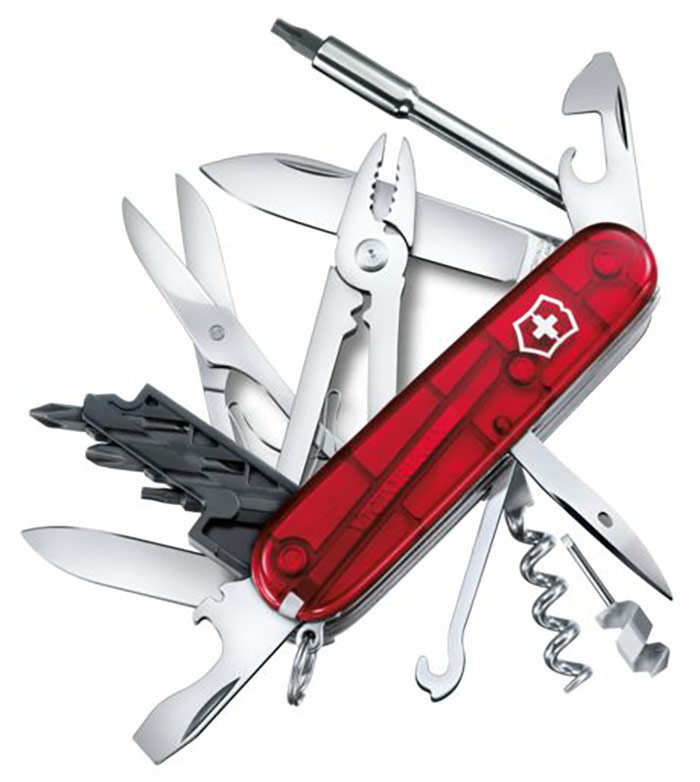
In 2000, Victorinox brought out a new series of knives designed to meet the needs of computer technicians as consumer electronics were really getting into full swing. The major change to the traditional 91mm Swiss Army Knife frame is the addition of an inline bit driver and a carrier to hold additional bits. All of the bits included in the knife are two-sided, with three in the carrier and one in the driver, for a total of 8 bits. They’re intended to work on most fittings found on electronics so they’re on the small side: a Philips #2/Slotted 4mm, Torx #8/Hex 4mm, Torx #10/Torx #15, and Pozidrive #0/Pozidrive #1.
Some of the crazy SwissChamp variants include a second bit driver with additional bits which you can order separately if they meet your needs more closely – a slotted 3/4mm, Torx 6/8, Hex 1.2/1.5, and a Hex 2/2.5mm. The bit carrier sits opposite of the driver and under it when the tool is closed, so the driver itself keeps the bits from falling out. The driver is magnetized to retain the bits while in use as well, and it also incorporates a half-stop so it can be used inline or at a 90 degree angle depending on what you’re doing – it’s very helpful.
Of course the rest of the knife is also extremely useful. It uses the newer translucent “plus” scales with the traditional toothpick and tweezers, plus a removable ballpoint pen and a removable straight pin under the corkscrew. The Cybertool M has the standard large and small straight blades, caplifter/large screwdriver/wire stripper, can opener/small screwdriver, and sprung scissors as most other 91mm models, but it also includes a set of sprung pliers with a wire crimper at the base as well. The back side of the knife has a sharpened awl, a corkscrew with the threaded-in fine eyeglass screwdriver, and the multi-purpose hook – as well as a keyring attachment. The CyberTool is a pretty hefty knife at 5.42 ounces and is best carried in a belt sheath as it’s bulky in a pocket.
The CyberTool M (previously called the CyberTool 34) is the standard CyberTool model, but there are multiple variants. The CyberTool S (previously Cybertool 29) is slimmer and omits the scissors, pliers, and hook. The CyberTool L (previously the 41) adds a wood saw and a metal file on the front, and a chisel and small slotted screwdriver on the rear. The CyberTool Lite adds an LED light and a magnifying glass to the CyberTool M. Regardless of which CyberTool you pick, you’ll be more prepared to fix things around the house or take apart your electronics. Putting them back together? That’s up to you!
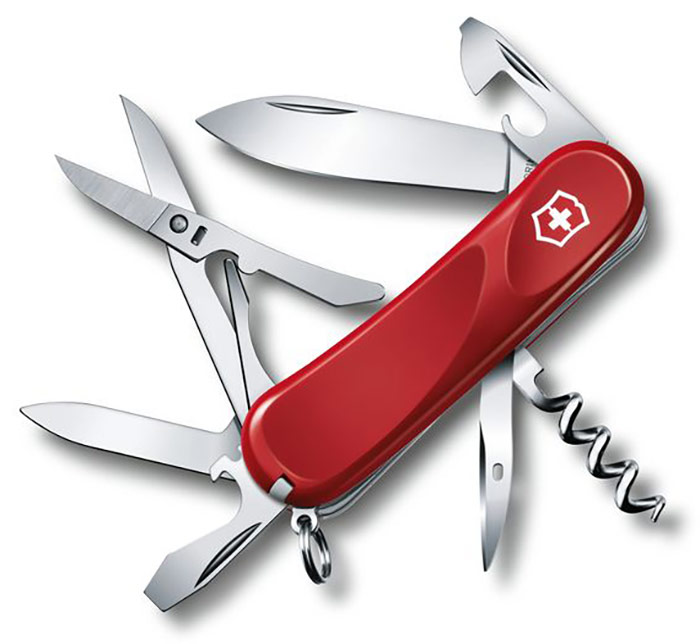
The Evolution series – and the related EvoGrip models – are actually leftovers from the Wenger brand, the other company that also made Swiss Army Knives until they were absorbed by Victorinox in 2005. Victorinox stopped selling Wenger branded models in 2014, but they continued making some Wenger designs as part of the Delemont collection with Victorinox branding.
The Evo models were interesting designs, reinterpreting the class Swiss Army shape with a more ergonmic hand-filling handle shape for a more secure grip. There are also similar EvoGrip variants which include high-traction grip inserts on the handles. Like most Swiss Army Knives, there’s a wide range of similar variants with minor component differences – for this list we picked the middle-range Evolution 14 model.
The Evo 14 is a three-layer model with a feature set centered on everyday use. There’s a large blade (of course) which is locking on the Evolution 14S model and a slipjoint on the regular models. A set of sprung scissors has a “micro serrated” edge that’s self-sharpening, and uses a backspring inside the knife to actuate – rather than a bent spring anchored in the scissors like the Victorinox style scissors. There’s a nail file with a pointed nail cleaner opposite the large blade, and of course the Evo 14 includes the cap lifter/large screwdriver/wire stripper – which locks in place – and the can opener/small screwdriver as well.
The backside of the knife contains a sharpened Awl/reamer, a keyring, and a Corkscrew. The scales hide a toothpick and a pair of tweezers, of course. There are multiple variants of the Evo – the EvoWood models features handsome walnut scales and obviously drops the tweezers and toothpick. The Evolution 16/16S is the same as the 14 but swaps the corkscrew out for a Philips driver. Love the mid-sized Swiss Army knife but want something a little different, check out the Evolution line!
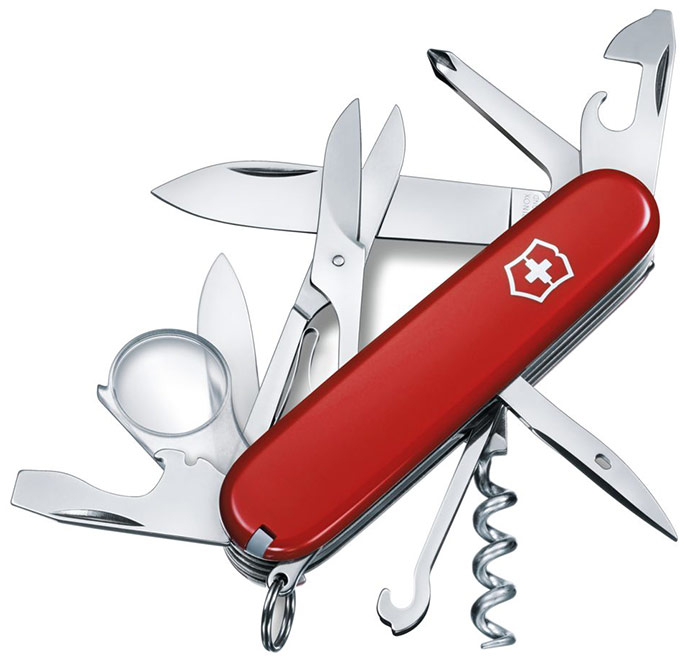
First, a bit of honesty here. I’m a knife nut, and the reason I’m a knife nut is the Victorinox Explorer. It’s the first knife I ever got – when I was very young Boy Scout, after spending hours poring over the Swiss Army catalog. I still have that knife – in fact, it’s been in my pocket since I started writing this article – and 20 years later it’s still an excellent, useful tool that gets used around the house frequently. It’s also unique in a lot of ways.
The Explorer is a great tool for camping, DIY, fixing the house or the cars, or anything else that needs doing. It’s a four-layer tool in the classic 91mm frame, but it includes some uncommon tools in a knife this small. The big draw is the folding magnifying glass with a glass lens, rare in smaller knives like the Explorer – which weighs only 3.6 ounces. Opposite the magnifying glass is an excellent in-line Philips driver – not offset like the rear mounted ones – which makes an excellent screwdriver. The Explorer includes the necessary “opening” tools – a cap lifter for your campside beer (with a large screwdriver and wire stripper) and a can opener for your campside dinner – with a small screwdriver. A pair of sprung scissors occupies a whole layer, and a combo of a large and a small blade attend to your cutting needs.
The rear side has three tools – a corkscrew, the multi-purpose hook, and a sharpened awl/reamer along with a keyring. The scales contain tweezers and a plastic toothpick. The Explorer is available in two variants – red or black cellidor handles – and was also available as the Explorer Plus with the multifunction “plus” scales which add a straight pin, removable ballpoint pen, and comes standard with an eyeglass screwdriver that threads into the corkscrew.

This 111mm body Swiss Army Knife became the new Soldier’s Knife in 2008 – replacing the 1961 Soldier’s Knife (or the Pioneer in the civilian market) with a larger, more robust and ergonomic knife for the military market. The big new feature it brought along with it was a one-handed opening main blade, able to be deployed with just your thumb like more modern knives – a very convenient addition. The blade measures 3.06” long and has a half-serrated edge and is held in place by a locking liner for safety. The larger handles are much more ergonomically formed, with divots for solid finger placement.
The 2008 Soldier begat the One-handed Trekker knife, a civilian version which features a few more implements and options. While the soldier has dual-density olive drab scales, the Trekker has more traditional textured nylon which hold tweezers and a toothpick. While the Soldier only comes with a half-serrated blade, the Trekker OHO is available with either a half-serrated or a plain edge blade. Beyond that, the tool load-out is the same: a large wood saw, cap lifter/large screwdriver/wire stripper (which also locks with a liner lock), can opener/small screwdriver, and on the back side a Philips driver and a sharpened awl/reamer. The Trekker series is large, robust, and heavy: 4.6 ounces makes it markedly larger than more traditional Swiss Army Knives.
There are many variations of the Trekker besides the aforementioned Soldier 2008. The one-handed German Army Knife (OH GAK) is similar to the Soldier 2008 but has olive drab handles with the Bundeswahr Eagle insignia in the handles. The standard Trekker has a plain-edge blade but does not have the one hand opening feature. The Forester is the same as the Trekker but swaps the Philips screwdriver for a corkscrew. The Master swaps out the wood saw for a large metal file, and the Dual Pro replaces the wood saw with a locking one-handed belt cutter and the Philips with a corkscrew. These 111mm one-handed locking tools take up a lot more pocket real estate but are generally heavier duty than the older standby 91mm models and are easier to use as well.
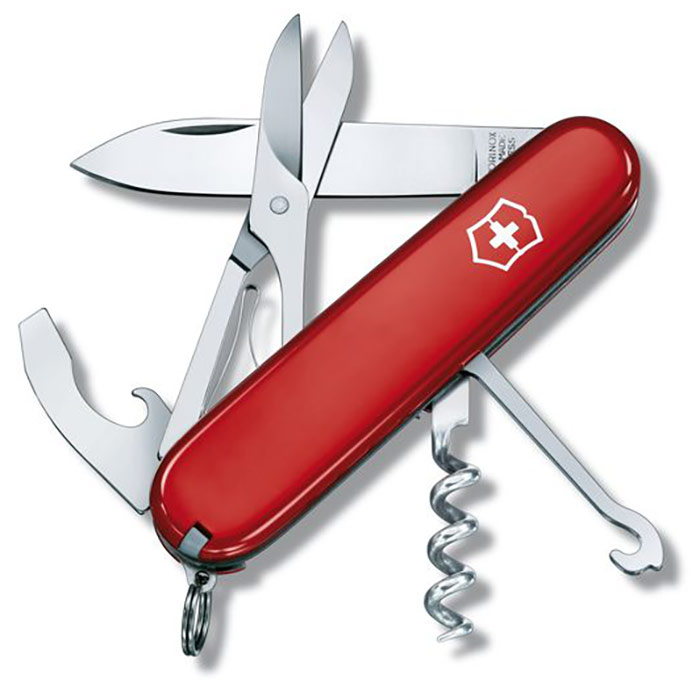
The name of the Compact is very fitting: it manages to fit 15 functions into a two-layer 91mm frame that only weighs 2.3 ounces. How? By combining features into single tools. Instead of a separate can opener and cap lifter the Compact has a unique combo tool that’s a cap lifter/can opener/screwdriver/wire stripper all in one. The only other layer tools are a single large blade and a set of standard sprung scissors.
The rear layers include a corkscrew with a threaded-in eyeglass screwdriver, a multi-purpose hook (later models have a nail file/match striker built into the spine of the hook), and a keyring. Since the Compact comes standard with the cellidor ‘Plus’ scales they’re loaded with features – tweezers, toothpick, removable ballpoint pen, and a straight pin under the corkscrew. There are very few variants of the Compact – red and black Cellidor scales plus other colors as custom variants. There aren’t many similar models – the older Timekeeper model (now discontinued) had the same feature set but with an analog clock in the scales instead of tweezers.
The rare Scientist (also discontinued) was another 2 layer 91mm but replaced the scissors and hook with a magnifying glass and philips driver. The ubiquitous Spartan model is the same size and width but trades the clever combo tool for separate openers, and features a large and small blade rather than a large blade and scissors – and no hook.
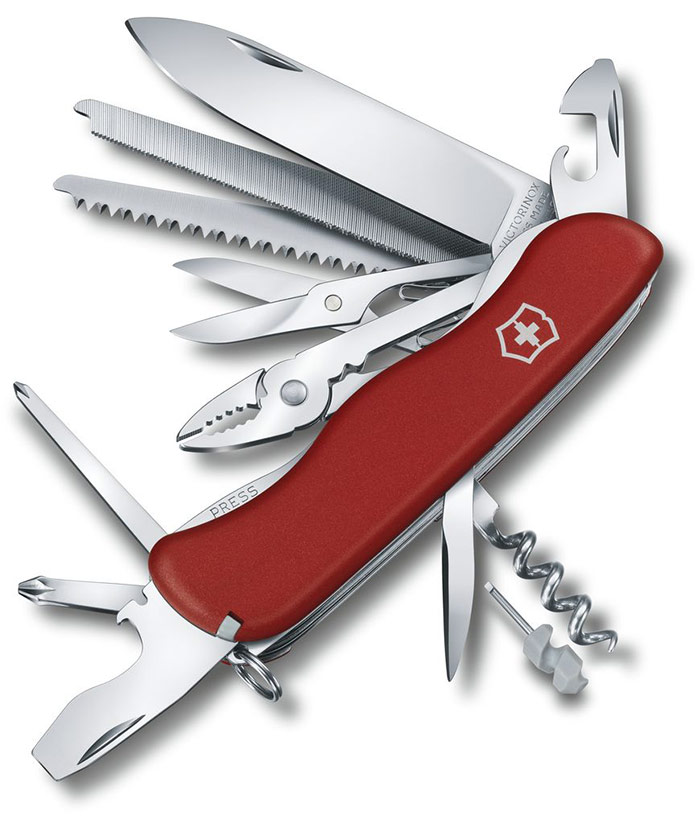
Now we’re getting into the big boys. The WorkChamp is the most feature-dense actually useful 111mm Swiss Army Knife- the Work Champ is a folding toolbox with heavy-duty tools and ergonomic grips for people that need to get things done.
Based on the larger 111mm frame that underpins the Soldier 2008/Trekker, the Work Champ is a 6-layer tool that weighs an impressive 8 ounces. It has a large folding blade that locks open (with a liner lock since an update in 2017) and a full length wood saw. A metal saw/file/nail file is next to that, and the Work Champ packs both a pair of sprung scissors and a pair of pliers. Of course there’s the obligatory cap lifter/large screwdriver/wire stripper – secured by a liner lock – and can opener/small screwdriver, but the WorkChamp also includes both a long and a short inline Philips drivers as well.
Back layer tools include a corkscrew with a threaded-in eyeglass screwdriver, a sharpened awl/reamer, and a keyring. The scales hold tweezers and a toothpick. There are a few similar models to the WorkChamp: the Hercules ditches the metal saw/file and mini screwdriver, and the Tradesman omits the scissors and the long Philips driver. Collectors may be interested in the WorkChamp XL, a 10-layer(!) 31 function tool that weighs a massive 12 ounces. It adds a rescue blade, a clip-point blade, an “equestrian hook”, the combo tool, and a shackle opener/marlin spike to the already heft tool load-out of the WorkChamp.
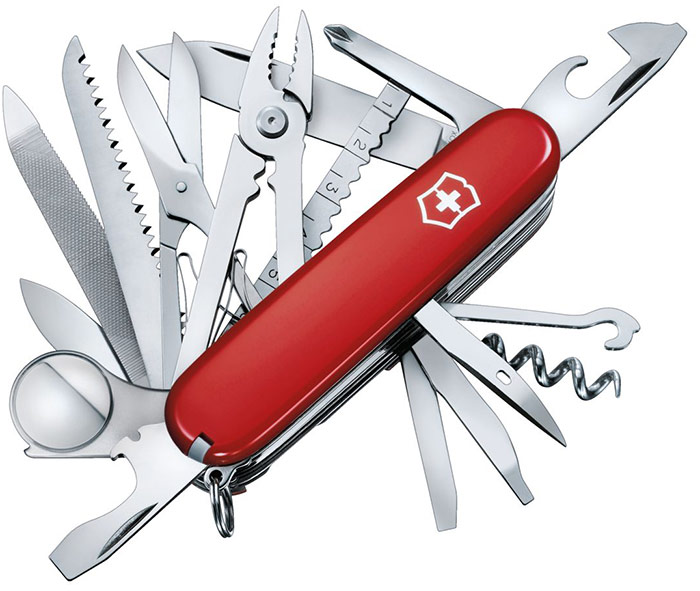
And we arrive at the pinnacle of Swiss Army Knives – the enormous SwissChamp. Boasting 8 layers of tools covering 33 functions, if you can’t do it with a SwissChamp you probably need some real tools – or some real help. It’s based on the classic 91mm Swiss Army Knife frame, but contains the entire kitchen sink of implements. The main tools include a large and small blade, sprung scissors and pliers, metal file and saw, wood saw, a magnifying glass and an inline Philips driver, a fish scaler, and the combo of a caplifter/large screwdriver/wire stripper and a can opener/small screwdriver.
The rear layer tools consist of the multipurpose hook, reamer/awl, corkscrew with thread-in eyeglass screwdriver, a fine screwdriver, a wood chisel, and a keyring. Since this is the cream of the crop Swiss Army Knife it includes the Plus scales which contain the tweezers, toothpick, straight pin, and removable ballpoint pen as well.
If that doesn’t sound like way too much, there are even larger versions of the SwissChamp. The SwissChamp XLT retails for $200 and adds three additional layers for 11. It adds a pharmacist’s spatula, electrician’s blade, small pruner blade, and the 3D bit driver from the CyberTool and has at least a passing semblance of usefulness. The same can’t be said of the $360 SwissChamp XAVT, a 15 layer slap in the face to common sense.
It adds a fully serrated blade, reamer, a second bit driver and carrier with more bits, the Wenger Universal wrench, a white LED light, the combo tool from the Compact, and a watch case opener. The back has an awl/reamer, two multipurpose hooks, two fine screwdrivers, a chisel, a corkscrew, and a TV remote. Only one of those things are made up. If that wasn’t enough, the scales themselves are from the Traveller and features a digital LCD display with a clock/alarm/timer, altimeter, barometer and thermometer. No one will ever carry or use these knives, but they make for a good conversation starter at parties.
Bonus: SwissCard
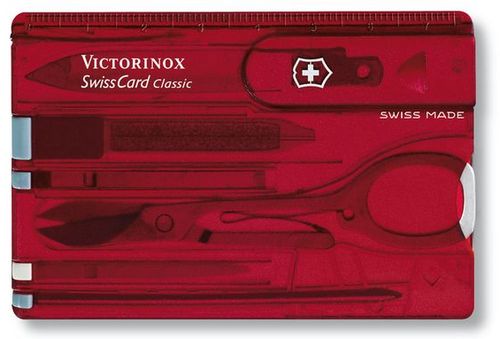
Don’t like the form factor of the classic SAK? Do you wish it fit in your wallet? Victorinox started production of the SwissCard in 1997 as a more portable option for people on the go – it’s the size of a credit card, with a polycarbonate body that holds several removable implements. It’s evolved into a number of versions over the years, but the idea is the same. The SwissCard Classic is around $28 and has a small blade and scissors, a nail file/cleaner, a straight pin, a pressurized ballpoint pen, a toothpick and tweezers. The body itself has ruler markings on it, and it comes in translucent red, black, and blue.
There’s the newer SwissCard Lite which has a small battery powered LED light, a blade, scissors, a straight pin, a ballpoint pen, tweezers, and a four-way screwdriver (two different size straight and Philips drivers) as well as a magnifying glass built into the body.
Narrowing down the list of best Swiss Army Knives is a tall order considering the shocking array of SKU’s in their catalog, but this is our ten best – did we miss your favorite? Let us know! Contact me with your feedback or comments.





